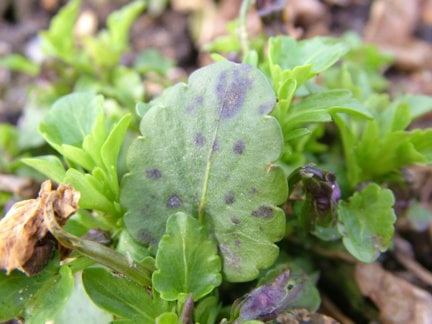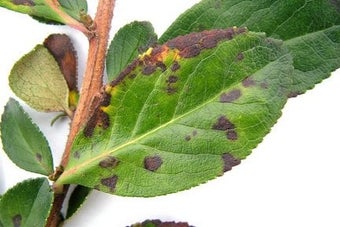
Quick facts
Common name - Pansy leaf spots
Scientific name - Various
Plants affected - Pansies
Main causes - Fungus and fungus-like (Oomycete) organisms
Timing - Winter until early summer
What are pansy leaf spots?
Spots and blotches on the leaves of pansies are caused by the fungal pathogens Ramularia lactea, R. agrestis and Mycocentrospora acerina.
Pansies also suffer from downy mildew caused by the fungus-like (Oomycete) organism Peronospora megasperma.
Symptoms
Symptoms vary, depending on the disease that is to blame;
Ramularia lactea:
- Dark greasy spots appear on the leaves, becoming brown in the centre
Ramularia agrestis:
- Pale tan spots and blotches similar to chemical scorch appear on the leaves
Mycocentrospora acerina:
- Very dark blotches appear on the leaves and stems, and the crown of the plant may rot
Downy mildew:
- Yellowish blotches appear on the upper leaf surface, corresponding to a grey, fuzzy, fungus-like outgrowth on the lower surface

Control
The RHS believes that avoiding pests, diseases and weeds by good practice in cultivation methods, selection, and encouraging or introducing natural enemies, should be the first line of control. If chemical controls are used, they should be used only in a minimal and highly targeted manner.
Non-chemical control
- Avoid repeat planting on the same site to prevent build-up of these pathogens in the soil
- Unlike those of downy mildew, spores of the leaf spot fungi are not wind-borne over long distances. Be aware that the most likely orginal source of the leaf spot fungi is, therefore, plants that are already infected when purchased. Do not buy plants that show any signs of leaf spot
- Wild pansies and violets may be sources of infection for garden pansies
Fungicides
The RHS recommends that you don't use fungicides. Fungicides (including organic types) may reduce , impact soil health and have wider adverse environmental effects. If you do intend to use a fungicide, please read the information given in the link and download below to ensure that use, storage and disposal of the product is done in a responsible and legally compliant manner.
The products listed in the ‘Fungicides for gardeners’ document below are legally available for use by home gardeners in the UK. This information is provided to avoid misuse of legal products and the use of unauthorised and untested products, which potentially has more serious consequences for the environment and wildlife than when products are used legally. Homemade products are not recommended as they are unregulated and usually untested.
There is no specific information available on the efficacy of any home garden fungicide against pansy leaf spots. No fungicides are available to home gardeners with activity against downy mildew.
Download
Fungicides for gardeners (Adobe Acrobat pdf document outlining fungicides available to gardeners)
Link
Biology
All of these pathogens produce spores on the affected parts of the leaf. The spores are spread by rain over short distances (leaf spots) or by wind over long distances (downy mildew). Mycocentrospora acerina and Peronospora megasperma also produce tough resting structures in the dead tissues which can contaminate the soil for several years, and the Ramularia species probably also do this.
The Ramularia species and Peronospora megasperma only infect pansies and violets, but Mycocentrospora acerina affects a wide range of plants and also causes a storage rot in carrots.






